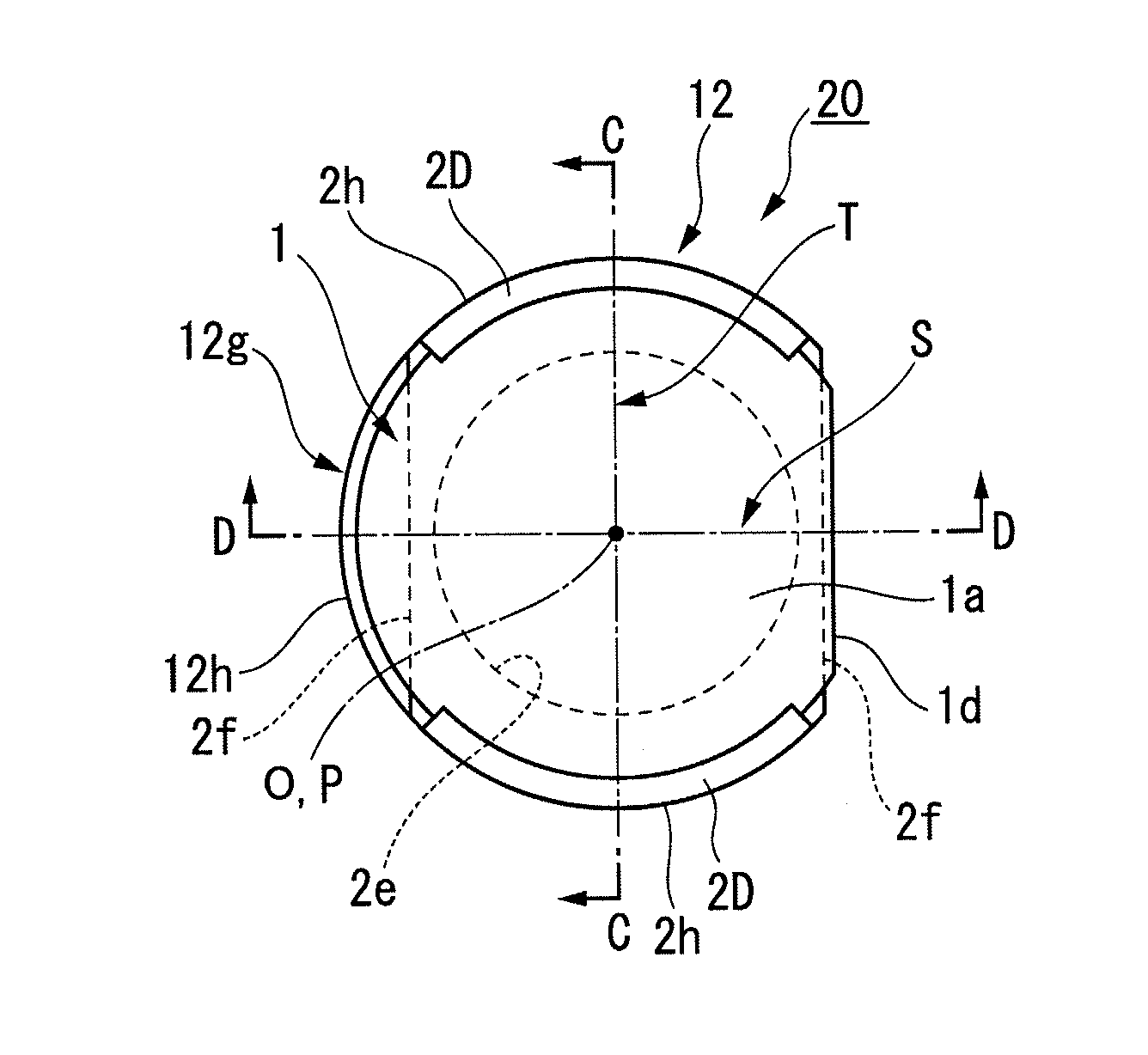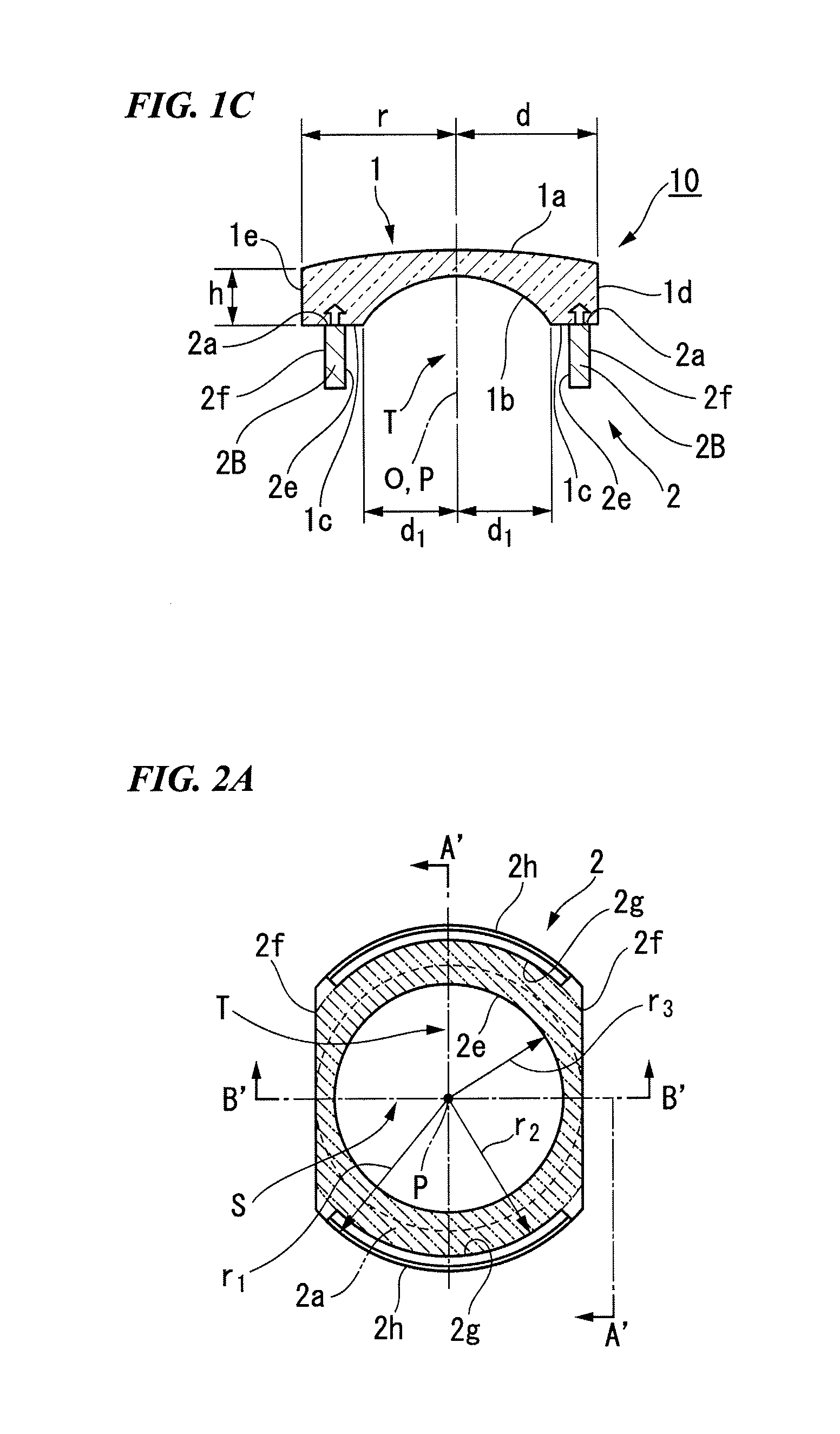Lens barrel and lens assembly
a technology of lens barrel and lens assembly, which is applied in the direction of mountings, instruments, optics, etc., can solve the problem that the lens is apt to move to the side without caulking portion readily caused by eccentricity
- Summary
- Abstract
- Description
- Claims
- Application Information
AI Technical Summary
Benefits of technology
Problems solved by technology
Method used
Image
Examples
first modified example
[0121]Next, a first modified example of the present embodiment will be described.
[0122]FIG. 4A is a schematic plan view showing the configuration of a lens assembly related to the first modified example of the embodiment of the present invention. FIG. 4B and FIG. 4C are a C-C cross-sectional view and a D-D cross-sectional view in FIG. 4A, respectively. FIG. 5A is a schematic plan view showing the configuration of a lens barrel related to the first modified example of the embodiment of the present invention. FIG. 5B is a C′-C′ cross-sectional view of FIG. 5A. FIG. 5C is a D′-D′ cross-sectional view of FIG. 5A.
[0123]The lens assembly 20 of the present modified example, as shown in FIGS. 4A, 4B, and 4C, includes a lens barrel 12 instead of a lens barrel 2 in the lens assembly 10 of the above embodiment.
[0124]The lens barrel 12 of the present modified example, as shown in FIGS. 5A, 5B, and 5C, has a configuration in which a D-shaped projection portion 12g that overhangs radially outward...
second modified example
[0136]Next, a second modified example of the present embodiment will be described.
[0137]FIG. 6A is a schematic plan view showing the configuration of a lens barrel related to the second modified example of the embodiment of the present invention. FIG. 6B is an E-E cross-sectional view in FIG. 6A.
[0138]A lens barrel 22 of the present modified example, as shown in FIGS. 6A and 6B, has a configuration in which one pair of lens-receiving surfaces 22a and a stepped portion 22f are provided instead of the lens-receiving surface 2a and stepped portion 12f of the lens barrel 12 of the above first modified example, and a stepped portion 22i is added. The lens barrel 22 can constitute a lens assembly by heat-caulking the lens 1 similarly to the lens barrel 12.
[0139]Hereinafter, differences from the above first modified example will mainly be described.
[0140]The pair of lens-receiving surfaces 22a are planes orthogonal to the central axis P, and are provided in circular-arc regions that become...
third modified example
[0147]Next, a third modified example of the present embodiment will be described.
[0148]FIG. 7A is a schematic plan view showing the configuration of a lens assembly related to the third modified example of the embodiment of the present invention. FIG. 7B is an F-F cross-sectional view in FIG. 7A, and FIG. 7C is a G-G cross-sectional view in FIG. 7A. FIGS. 8A, 8B, and 8C are a schematic left side view, plan view, and right side view showing the configuration of a lens barrel related to the third modified example of the embodiment of the present invention. FIG. 8D is a G′-G′ cross-sectional view in FIG. 8B.
[0149]The lens assembly 30 of the present modified example, as shown in FIGS. 7A, 7B, and 7C, is an assembly in which a lens 31 obtained by making the distance from the optical axis O of the D-cut surface 1d of the lens 1 smaller is a heat caulking in the thickness direction at the outer edge portion thereof and is fixed to a lens barrel 32. Caulking and fixing portions 32D show por...
PUM
 Login to View More
Login to View More Abstract
Description
Claims
Application Information
 Login to View More
Login to View More - R&D
- Intellectual Property
- Life Sciences
- Materials
- Tech Scout
- Unparalleled Data Quality
- Higher Quality Content
- 60% Fewer Hallucinations
Browse by: Latest US Patents, China's latest patents, Technical Efficacy Thesaurus, Application Domain, Technology Topic, Popular Technical Reports.
© 2025 PatSnap. All rights reserved.Legal|Privacy policy|Modern Slavery Act Transparency Statement|Sitemap|About US| Contact US: help@patsnap.com



